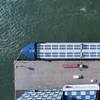Ingram Lines Completes Standardization
Under the direction of David O'Neill, Assistant Vice-President of operations based in Paducah Kentucky, the firm is undertaking a repower and engine standardization program in the 16 vessels of their Ingram Support Services division. These boats, in the 600 to 1,800 hp range, are employed primarily in demanding short haul and fleeting operations. Currently powered with four different makes of engines, the company is working to standardize to Cummins marine engines.
A repower currently underway at James Marine's Paducah River Services facility is of particular interest. The 65- x 26- x 9-ft. pushboat, Dick Tomayko, was built in 1981 with twin engines generating a total of 1,400 hp. The boat was subsequently powered up with the addition of after-cooling which brought the boat to a total 1600 hp. Unfortunately this was just too much power for the hull size and the boat's performance has suffered from propeller cavitation causing vibration and reduced bollard power.
The pair of 900 hp engines were removed and replaced with a pair of IMO compliant Cummins KTA19 M-3 engines rated at 600 hp each. These were coupled to Twin Disc 540 gears with 7:1 ratios turning seven-inch shafts. The old propellers were replaced with Rolls Royce Naval Marine's "Next Generation" Bird Johnson variable pitch 5-blade work wheels. With a 68-in. diameter, the propellers' pitch varies from 53.5 in. at .03 radius, to 60 in. at .07 radius and 59.3 in. at the blade tip. Designed in consultation with naval architect Corning Townsend, the propellers, with these specs, offer up to 50 percent reduced propeller induced vibration up the shaft and thru the hull for superior backing characteristics while maintaining comparable thrust to that of conventional props.
The engines are equipped with Cummins' Centinel Oil Replenishment systems that removes a small amount of used oil and sends it to the fuel tank. The used oil is then blended with the fuel and burned during normal combustion. Simultaneously, Centinel adds the same amount of new oil from a make-up tank into the engine. The result is a better-protected, better-running engine offering enhanced environmental characteristics with less time and money spent on oil system maintenance. Ingram Support Services Port engineer Robert King anticipates that the new engines will only require new filters every 1,000 hours and an oil change every 4,000 hours.
On its return to service in February the Dick Tomayko will also have a refurbished superstructure, new pilot house controls and a pair of Cummins 6BT powered 60 kW gensets. Plans call for other boats in the fleet to undergo similar upgrades and standardization that will, in addition to the engines and gensets, include standardized components such as gears, air compressors, steering systems, shafts and propellers.
David O'Neill explains that, "Choosing Cummins as our small engine partner feels like such a natural fit. Their technological advances, customer focus and around-the-curve thinking are the must ingredients for a 21st Century relation."









